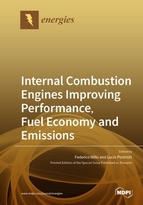Internal Combustion Engines Improving Performance, Fuel Economy and Emissions
A special issue of Energies (ISSN 1996-1073). This special issue belongs to the section "B: Energy and Environment".
Deadline for manuscript submissions: closed (31 December 2019) | Viewed by 55807
Special Issue Editors
Interests: internal combustion engines; hybrid powertrains; modelling and simulation
Special Issues, Collections and Topics in MDPI journals
Special Issue Information
Dear Colleagues,
Internal combustion engines are facing unprecedented challenges to reduce their adverse environmental impact in terms of pollutant and greenhouse emissions, while continuing to improve their performance. To achieve the ambitious goals of meeting US Tier3 and post-Euro 6 emissions standards within the extremely demanding Real Driving Emissions test protocols, while simultaneously reaching the challenging post-2020 CO2 emissions targets, the automotive industry is going to deploy an unparalleled mix of technological developments, ranging from alternative fuels, advanced fuel injection, and combustion technologies, to aftertreatment and powertrain electrification.
This Special Issue aims therefore to encourage both academic and industrial researchers to present their latest findings concerning technologies enabling pollutant emissions reduction and fuel economy and performance improvements for internal combustion engines, providing to readers a comprehensive, unbiased, and scientifically sound overview of the most recent research and technology developments.
Prof. Federico Millo
Prof. Lucio Postrioti
Guest Editors
Manuscript Submission Information
Manuscripts should be submitted online at www.mdpi.com by registering and logging in to this website. Once you are registered, click here to go to the submission form. Manuscripts can be submitted until the deadline. All submissions that pass pre-check are peer-reviewed. Accepted papers will be published continuously in the journal (as soon as accepted) and will be listed together on the special issue website. Research articles, review articles as well as short communications are invited. For planned papers, a title and short abstract (about 100 words) can be sent to the Editorial Office for announcement on this website.
Submitted manuscripts should not have been published previously, nor be under consideration for publication elsewhere (except conference proceedings papers). All manuscripts are thoroughly refereed through a single-blind peer-review process. A guide for authors and other relevant information for submission of manuscripts is available on the Instructions for Authors page. Energies is an international peer-reviewed open access semimonthly journal published by MDPI.
Please visit the Instructions for Authors page before submitting a manuscript. The Article Processing Charge (APC) for publication in this open access journal is 2600 CHF (Swiss Francs). Submitted papers should be well formatted and use good English. Authors may use MDPI's English editing service prior to publication or during author revisions.
Keywords
- internal combustion engines
- pollutant emissions
- aftertreatment systems
- fuel economy
- CO2 emissions
- hybrid electric powertrains
- engine performance







